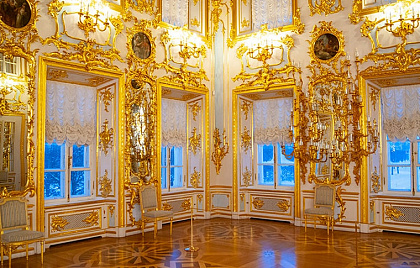The Upper Garden of Peterhof
The Upper Garden of Peterhof was drafted by Peter I and used primarily for farming. Fruit, vegetables and medicinal hers were grown there. Ponds were used for fish-farming and to collect water for fountains of the Lower Park.
But attitudes of the Tsar’s growing court changed, and by the middle of the 18th century most guests arrived in Peterhof by land but not by sea as in Petrine times.
It was Peter I’s daughter, Empress Elizabeth, who made the Grand Palace really grand. At the order of Empress Elizabeth, architect Rastrelli added one storey and built the House church of SS Peter and Paul, Pavilion under Coat-of-Arms and connected them to thecentral part of the palace by galleries. The central entrance to the palace was from the side facing the road to St.Petersburg.
For this reason it was decided to upgrade the territory of the Upper Garden and replace vegetable beds with a regular park. Three fountains were made on the central axis of the park.
Later, in Paul I’s reign, one of those fountains was decorated with a sculptural composition which Paul I had purchased in his tour of Europe as heir to the throne: the pedestal is topped by a statue of the god of the sea Neptune and the base has figures of Nymphs, sea horse, and putti on dolphins and sea dragons.The Neptune fountain is still the centerpiece of the Upper Garden.
The western and eastern parts of the garden have square shaped basins with fountains decorated with statues Spring and Summer.
From the Upper Garden you can enjoy the southern façade of the Grand palace which has marble statues of gods and goddesses made by Italian sculptor Antonio Bonazza in the middle of the 18th century. Built on 15 hectares only, the garden is fairly small but will give you a sense of vastness and… approach to something incredibly beautiful.












